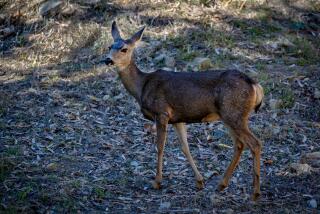Plan Formed to Poison Island’s Rats
- Share via
ANACAPA ISLAND — By the end of the year, helicopters could drop tons of poison pellets in an attempt to exterminate all the rats inhabiting the rocky island off Ventura County under a plan the National Park Service released Tuesday.
If the aerial assault works as planned, it could lead to a profusion of native plants, flowers and seabirds to replenish those damaged by marauding rodents, scientists say.
But while rat eradication efforts have worked on some islands around the world, many such attempts have failed. The black rat is a formidable adversary not easily dislodged. It breeds so rapidly, producing a new generation every three weeks, that just a single mating pair left behind could quickly repopulate 700-acre Anacapa Island.
“Rats survived nuclear explosions in the Pacific. They are very adaptable creatures,” said Paul Collins, wildlife biologist at the Santa Barbara Museum of Natural History. “But Anacapa is a small island, so if they do a concerted eradication effort it could well work there.”
The program marks the first concerted attempt to get rid of all 2,000 or so rats living on the three small islets that make up Anacapa.
“It will be a major milestone,” said Kate Faulkner, chief of natural resources management at the park.
The plan is part of a program at Channel Islands National Park to return native flora and fauna to the islands. Poison bait was deemed the most efficient way to dispense with the rats, even though it could could kill an undisclosed number of hawks, gulls and owls that eat the poisoned rats, officials say.
Anacapa Island would be closed for a few days, either in November or December, during the killing.
The Park Service proposes dropping up to 9,700 pounds of the rodenticide brodifacoum. The first dose would be applied to east Anacapa late this year, and middle and west Anacapa isles would be treated in November or December 2001, according to the park’s plan.
Aerial application of poison bait was deemed safer than trying to set traps along cliffs and across the island, Faulkner said. It holds promise for killing the most rats with the least amount of time or risk to people or other animal species.
Some deer mice also might die, but they can be replenished using stock from the islets not yet treated. Some are infected with hantavirus, a potentially lethal disease for humans, but the Park Service wants to maintain them because they are native to Anacapa.
The rat-eradication plan is subject to approval by the Park Service’s regional headquarters and the U.S. Environmental Protection Agency in San Francisco.
More to Read
Sign up for Essential California
The most important California stories and recommendations in your inbox every morning.
You may occasionally receive promotional content from the Los Angeles Times.










